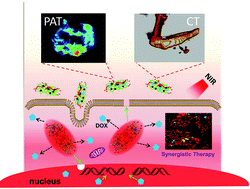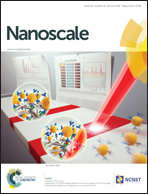The polyvinylpyrrolidone functionalized rGO/Bi2S3 nanocomposite as a near-infrared light-responsive nanovehicle for chemo-photothermal therapy of cancer†
Abstract
Recently, a combination of chemotherapy with photothermal therapy (PTT) has received great attention for the construction of a near infrared (NIR)-controlled drug-delivery system for synergistic treatment of cancer, ultimately resulting in the enhancement of the therapeutic efficacy of anticancer drugs. Here, we developed a novel system for synergistic cancer therapy based on bismuth sulfide (Bi2S3) nanoparticle-decorated graphene functionalized with polyvinylpyrrolidone (PVP) (named PVP-rGO/Bi2S3). The as-prepared PVP-rGO/Bi2S3 nanocomposite has a high storage capacity for anticancer drugs (∼500% for doxorubicin (DOX)) and simultaneously has perfect photothermal conversion efficiency in the NIR region. The results of the in vitro accumulative drug release test manifests that the PVP-rGO/Bi2S3 nanocomposite could be applied as a dual pH- and NIR-responsive nanotherapeutic carrier for the controlled release of DOX from DOX-loaded PVP-rGO/Bi2S3 (PVP-rGO/Bi2S3@DOX). Moreover, the treatment of both cancer cells (including Hela, MCF-7, HepG2 and BEL-7402 cells) and BEL-7402 tumor-bearing mice with the PVP-rGO/Bi2S3@DOX complex followed by NIR laser irradiation produces significantly greater inhibition of cancer cell growth than the treatment with NIR irradiation alone or DOX alone, exhibiting a synergistic antitumor effect. Furthermore, due to the obvious NIR and X-ray absorption ability, the PVP-rGO/Bi2S3 nanocomposite could be employed as a dual-modal contrast agent for both photoacoustic tomography and X-ray computed tomography imaging. In addition to the good biocompatibility, the PVP-rGO/Bi2S3 nanocomposite paves a potential way for the fabrication of theranostic agents for dual-modal imaging-guided chemo-photothermal combined cancer therapy.


 Please wait while we load your content...
Please wait while we load your content...